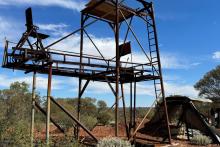After kicking the ball out of the park in the last lithium boom with its Mt Marion lithium mine, Neometals has backed up the truck for another tilt at what many believe is an impending 3rd lithium boom. The company has locked in a 60-day exclusive option to access a portfolio of inactive oil and gas wells in Utah’s Paradox Basin to fast-track evaluation of lithium- and potassium-rich brines that might be lurking below.


After kicking the ball out of the park in the last lithium boom with its successful Mt Marion lithium mine in WA’s Goldfields region, Neometals has backed up the truck for another tilt at what many believe is an impending 3rd lithium boom. In an innovative move the company has locked in a 60-day exclusive option to access a portfolio of inactive oil and gas wells in Utah’s Paradox Basin to fast-track evaluation of lithium- and potassium-rich brines that may be lurking below.
The capital-light deal, executed through Neometals’ wholly-owned subsidiary Neometals Energy, part owned by its US partner Omaha Value, will target inactive wells held by private US firm, American Helium LLC and London-listed Ascent Resources.
The deal embraces leases in the Lisbon Valley area, adjacent to the Lisbon Valley gas plant and enables low-cost brine sampling from deep, artesian reservoirs in thick evaporite sequences.
If exercised, the access and use licence would grant exclusive rights to utilise well infrastructure for exploration, extraction and re-injection, which would slash evaluation timelines for Omaha Value’s 47,000-acre Utah brine project through its subsidiary Utah Brine Corporation.
Key terms of the option agreement include a US$50,000 exclusivity fee with Neometals’ share landing at US$25,500, a US$1.9 million permitting fee and a US$200,000 annual access fee.
Additionally, a 2.5% gross revenue royalty is applicable post any commercial extraction.
Neometals managing director and CEO Chris Reed said: “Neometals has a long history in lithium - from the development of a globally significant spodumene project, to advancing innovative lithium processing technologies. This agreement is an exciting opportunity to apply our expertise in the Paradox Basin, leveraging existing well, pipeline and energy infrastructure to accelerate the evaluation of lithium and potassium potential in Utah.”
A January 2024 ASX-announcement by Mandrake Resources confirms the Paradox Basin’s credentials, following its wireline downhole brine sampling at five oil and gas wells.
Mandrake reported brine samples assaying up to 147 milligrams per litre (mg/L) lithium and more than 33,600mg/L potassium, alongside an outstanding 3480mg/L bromine across multiple horizons, underscoring the basin's emerging status as a US critical minerals hub.
Importantly, the over-pressure artesian reservoirs are expected to deliver strong natural flows to surface, minimising pumping requirements and OPEX.
Utah recently topped the Fraser Institute's 2023 mining investment attractiveness ranking, edging out Nevada and Saskatchewan, with Western Australia in fourth place, thanks to Utah’s competitive taxes, stable regulations, and strong geological potential.
Both lithium and potash feature on the US Department of the Interior's expanded 2025 critical minerals list, unlocking FAST-41 expedited permitting and federal incentives from the Department of Energy and Department of Defense.
FAST-41 is shorthand for Title 41 of the Fixing America’s Surface Transportation (FAST) Act, a 2015 US federal law designed to cut through permitting red tape for major infrastructure projects.
In the critical minerals world, FAST can be a game-changer as eligible projects benefit from expedited reviews, dedicated project managers and priority for critical commodity operations such as lithium and potash.
The Trump administration supercharged FAST this year via executive orders, adding dozens of domestic mining/refining projects to the FAST-41 queue to invigorate onshore supply chains and dodge China reliance.
Neometals aims to apply its direct lithium extraction (DLE) technology, already validated on Paradox Basin brines by developers like Mandrake, yielding 80-98% lithium recoveries against typical 30-65% recoveries from evaporation ponds.
The Utah brine project aligns perfectly with Neometals’ low-cost strategy, with its low-capex infrastructure, cheap access to idle wells, cheap Rocky Mountain power, a railhead 65km away at Moab and Henry Hub-linked gas supplies.
Henry Hub is a physical gas hub in Louisiana where multiple gas pipelines intersect and it has become a benchmark natural-gas pricing point in the US.
The gas link is important as direct lithium extraction plants are often gas-heated for regeneration cycles, which means cheap predictable Henry Hub-linked gas represents another low-cost win and a big advantage over remote South American or Australian brine projects that pay much more for delivered gas.
All three infrastructure credits are already close at hand because of decades of local oil and gas activity, so Neometals can simply piggy-back on them for relatively low additional cost.
Neometals’ technical, legal and commercial due diligence is currently underway, alongside negotiations for the definitive licence.
As demand for rare earths hits fever pitch, many believe lithium will get dragged out of its slumber sometime soon as the two critical minerals largely go together as both are a necessary part of electric vehicle manufacturing.
Neometals will repurpose yesterday’s gas ghosts for tomorrow’s battery brines in a smart, strategic, low capital move.
And this isn’t Neometals first rodeo in the lithium space either. During the last lithium boom many developed lithium resources and reserves but very few managed to build and profitably operate a mine – Neometals did.
And it also has earnt its stripes in the lithium technology space too. All of which combine to make its foray into US lithium brines a potentially perfect re-entry into the lithium market.
Is your ASX-listed company doing something interesting? Contact: mattbirney@bullsnbears.com.au













